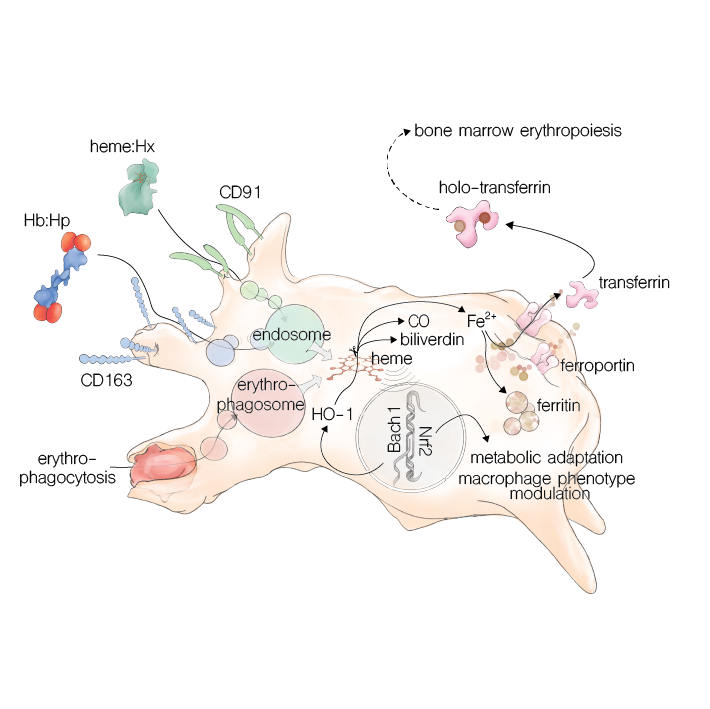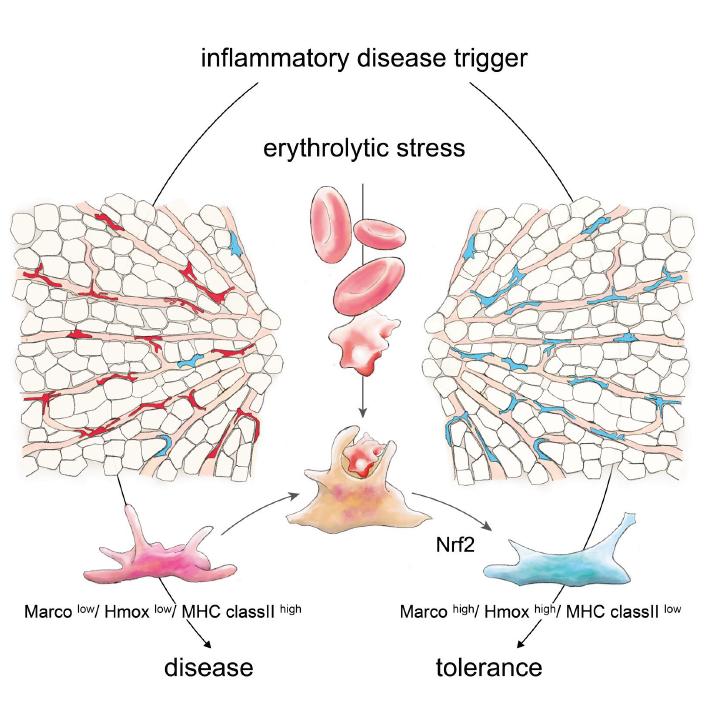Phagocyte reprogramming and heme-suppressed immunity in hemolytic anemias
Upon hemolytic stress, receptor-mediated clearance of cell-free hemoglobin, phagocytosis of damaged erythrocytes and sequestration of RBC toxins represent a key homeostatic function of the mononuclear phagocytes of the reticuloendothelial system limiting hemoglobin and heme toxicities. Through heme-oxygenase 1 (Hmox1), macrophages degrade heme and provide the iron source for the erythropoiesis. We have demonstrated that heme-exposure transforms bone marrow (BM)-derived inflammatory macrophages into anti-inflammatory erythrophagocytes. Erythrophagocytes display high expression of genes related to heme-degradation, antioxidant metabolism, and iron-handling, supporting their homeostatic function in erythropoiesis and protection against hemolysis-driven pathologies. Simultaneously, heme-exposure profoundly suppressed MHC-class II expression and induced tolerance against inflammatory activation by endogenous (e.g., CD40 ligation) and foreign (e.g., TLR agonists) immune-activation signals. This anti-inflammatory macrophage polarization, driven by heme, could be an essential mechanism by which the immune system is regulated to prevent overactivation against self-antigens in patients with acute and chronic hemolysis or in a wound. Over the last few years, we have invested strong efforts to establish experimental models (e.g., different genetic models of hemolysis) and analytic tools in the field of system biology (e.g., single-cell RNAseq analysis of macrophage populations in tissues) to investigate this process in vivo.
Pathophysiology of erythrophagocytes.
(adapted from Buehler PW et al., 2020, Ingoglia G et al., 2020 and Pfefferlé M. et al. 2020).
Readings
Hemolysis transforms liver macrophages into anti-inflammatory erythrophagocytes
Pfefferlé M, Ingoglia G, Schaer CA, Yalamanoglu A, Buzzi RM, Dubach IL, Tan G, López-Cano EY, Schulthess N, Hansen K, Humar R, Schaer DJ, Vallelian F. (2020).
The Journal of Clinical Investigation.
https://doi.org/10.1172/JCI137282
Abstract
During hemolysis, macrophages in the liver phagocytose damaged erythrocytes to prevent the toxic effects of cell-free hemoglobin and heme. It remains unclear how this homeostatic process modulates phagocyte functions in inflammatory diseases. Using a genetic mouse model of spherocytosis and single-cell RNA sequencing, we found that erythrophagocytosis skewed liver macrophages into a unique anti-inflammatory phenotype that we defined as Marcohigh/Hmoxhigh/MHC-class IIlow erythrophagocytes. This phenotype transformation profoundly mitigated disease expression in a model of an anti-CD40-induced hyperinflammatory syndrome with necrotic hepatitis and in a non-alcoholic steatohepatitis model, representing two macrophage-driven sterile inflammatory diseases. We reproduced the anti-inflammatory erythrophagocyte transformation in vitro by heme-exposure of mouse and human macrophages, yielding a distinctive transcriptional signature that segregated heme-polarized from M1- and M2-polarized cells. Mapping transposase-accessible chromatin in single cells by sequencing (scATAC-seq) defined the transcription factor NFE2L2/NRF2 as a critical driver of erythrophagocytes, and Nfe2l2/Nrf2-deficiency restored heme-suppressed inflammation. Our findings point to a pathway that regulates macrophage functions to link erythrocyte homeostasis with innate immunity.
Line-selective macrophage activation with an anti-CD40 antibody drives a hemophagocytic syndrome in mice
Ingoglia G, Yalamanoglu A, Pfefferlé M, Dubach IL, Schaer CA, Valkova K, Hansen K, Schulthess N, Humar R, Schaer DJ, Vallelian F. (2020).
Blood advances, 4(12), 2751-2761.
https://doi.org/10.1182/bloodadvances.2020001624
Abstract
Haptoglobin Therapeutics and Compartmentalization of Cell-Free Hemoglobin Toxicity
Buehler PW, Humar R, Schaer DJ. (2020).
Trends in Molecular Medicine.





